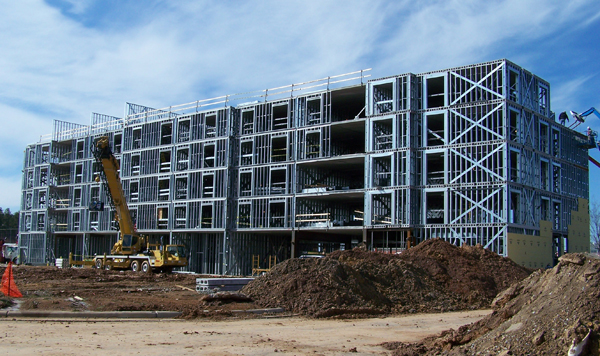It has now been approximately six months since the global coronavirus pandemic started wreaking havoc on the United States. While many raw materials have seen little fluctuation in price throughout the pandemic, the same cannot be said for the cost of wood.
Not only is the cost of lumber sky-high, it is also scarce. So, what happened and why are wood builders now scrambling for materials?

WHERE DID ALL THE LUMBER GO?
Due primarily to a booming US residential new construction market, America’s lumber inventory was already considered to be lower than normal at the start of 2020. An additional factor affecting the US’ inventory was that China had shut down mills in response to the coronavirus, and they were facing a large decline in wood importing/exporting during January and February.
As coronavirus crept into the US, millions of Americans found themselves stuck at home with extra money from cancelled vacations or unexpected stimulus checks, and many had nothing better to do than to start knocking home improvement projects off of their to-do list. Surprisingly, the pandemic was proving to be the ideal opportunity to become a DIYer, or finally contract out work on that new deck or remodel. Home improvement stores and lumber yards were flooded with people buying up lumber faster than anyone ever could have predicted. The wood mills, which were either closed or operating at a reduced capacity, were not expecting this and were totally unprepared for this surge.
While coronavirus has definitely been the biggest contributing factor to the lumber shortage, it isn’t the sole reason why there isn’t enough lumber. The world’s timber supply has been in jeopardy for quite some time due to tiny little bugs called bark beetles. There are over 600 species of bark beetles; yet, it is the mountain pine beetle that has a ruthless reputation for killing a tree from the inside out. Over the past 15 years warmer climates have primarily contributed to the outbreak in this bug population that has single-handedly destroyed enough timber in British Columbia to build 9 million single-family homes. However, they are not just decimating trees in Canada. In the past year alone, mountain pine beetles have also killed trees at record numbers in the United States. The U.S. Forest Service estimates that over the next 10 years, 100,000 trees on average will fall daily as a result of the bark beetle epidemic.
However, the reasons for scarce lumber don’t stop there. Another contributing factor is all the past wildfires in the western parts of the US and Canada. Unfortunately 2020 has been the most destructive wildfire season recorded in California history, with over 2.2 million acres destroyed. While these wildfires were more of a strong contributing factor to lumber shortages in previous years, the recent wildfires are still making it that much harder for the timber mills to keep up with demand.
LUMBER PRICES SOAR
If you find yourself feeling like you’ve found a pot of gold, simply because you got lucky enough to acquire enough lumber to complete your wood project, you’ll quickly turn that smile upside down when you see the price tag.
Let’s take it back to middle school economics…. lumber prices are sky high right now because of the simple economic principle of supply and demand. When there isn’t as much supply and there’s a lot of demand; prices go up. And right now the price for lumber is higher than ever!
Wood prices have increased as much as 130% in the past five months!
But, that seems pretty excessive, right?! Well, there’s more to it…
Much of the lumber we use in the US is milled overseas, so when you start adding up all the various tariffs on the imports, the price starts climbing more than just a typical supply and demand price surge. That’s real bad news for those who were planning on building a home, or any structure, out of wood.
According to the National Association of Home Builders the current high price of lumber is increasing the price to build a wood framed single-family home by more than $16,000. Lead times are just getting longer and longer to acquire the lumber, and there’s really no end in sight. In fact, it very well could get worse before it gets better if the US is faced with a bad hurricane season – wood priority will go to FEMA.
COLD-FORMED STEEL TO THE RESCUE
Sky-high lumber costs and longer lead times on materials are leaving project owners and builders searching for a better solution to wood. Cold-formed steel (CFS) to the rescue!
CFS is a framing option that has taken the industry by storm. It is more popular today than ever before for the construction of hotels and residental projects such as single family homes, dormitories, and apartment complexes.
Not only can cold-formed steel offer you a better quality framing material for your project, but you might also be surprised to find that currently it’s a cheaper option. In fact, recent comparisons have found that builders can save approximately 24% when switching to a cold-formed steel framing package.
TEN MORE REASONS TO CHOOSE STEEL
Cold-formed steel benefits go far beyond just a number on paper for the framing package, especially in today’s market when CFS can be more competitive than ever against wood framing. Looking beyond simply the high price and limited availability of lumber right now, here are ten more reasons why you should choose steel over wood for your next project.
- CFS is noncombustible (unlike wood it will not burn or fuel a fire). It saves projects big money by eliminating the need for expensive sprinkler systems in high occupancy buildings, and will slash insurance costs. Cold-formed steel framing saves not only your property, it saves lives.
- CFS is inorganic, making it resistant to mildew or mold.
- CFS is vermin and insect resistant. You have no fear of the framing ever being compromised by mice, rats, squirrels, termites or other insects.
- CFS is resilient to cold weather and moisture. Harsh winters and rainy days can really delay a wood-framed project. Time is money, and with cold formed steel your project has a better chance of staying on track when Mother Nature is in one of her moods.
- CFS provides your job with the most efficient framing solution on the market, because steel is stronger pound for pound than any other building material.
- CFS is manufactured with punch-outs in the studs which streamlines plumbing and electricity work, saving you time and money in labor. It will also not warp or settle, unlike wood framing.
- CFS has been known to shave months off of construction schedules, especially large projects where the wall panels can be panelized off-site. This has allowed homeowners to move in sooner and commercial owners to open their buildings earlier than anticipated – an opportunity to collect more profits and/or tenant rent.
- CFS is resistant to seismic loads, ballistic penetration, and blast threats. CFS is truly one of the most resilient building materials available.
- CFS products are made with at least 25% recycled steel. Recycling wood building materials can be a grueling process, whereas recycling steel is straight-forward and it can be recycled indefinitely. So, you’re also helping the planet when you choose CFS!
- CFS is coated with a zinc galvanization; this creates a barrier against corrosion that has been identified to last nearly 700 years before corrosion becomes an issue for deterioration. You don’t get that type of durability from wood!
FROM WOOD TO STEEL… WE’LL SWITCH IT FOR YOU
If you have a project that was originally designed with wood, consider converting the project to cold-formed steel. The Steel Network offers a complimentary design-assist service that will transform your building from a wood-framed structure to a CFS structure. This service will provide you with a complete project representation of material and labor savings, and even a projected project completion schedule. In order to get a true idea of cost savings for the job, it’s important to look at the big picture for the entire project (framing package, labor, insurance costs, project longevity, etc).
Authored by: Kristy Andrews
Kristy holds a B.S. in Communications from ECU, and is a Technical Marketing Coordinator at The Steel Network. She has been employed with TSN for over 19 years, working primarily with the design community of Architects and Structural Engineers.
